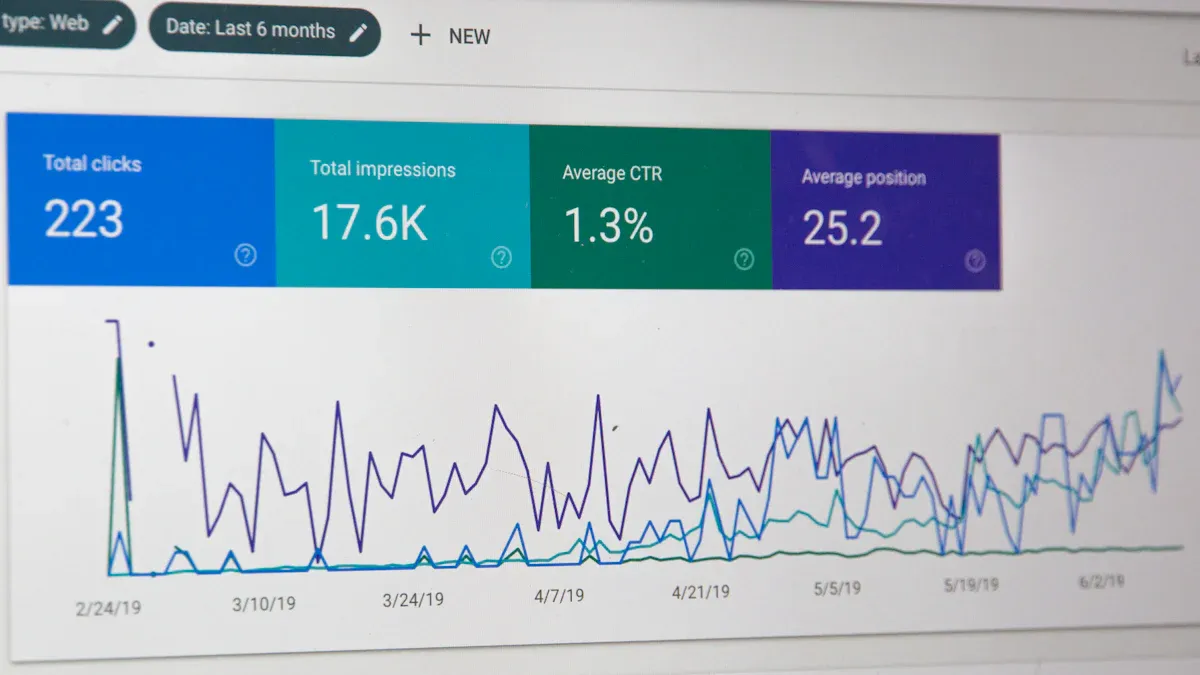How to Perform Keyword Research for SEO Optimization

Finding the right keywords is key to good SEO. It shows you the exact words people use to search online. This helps you make content that matches what they need, making your site easier to find.
Good keyword research has clear benefits. Pages with target keywords get 45% more clicks. Being higher in search results can raise clicks by 2.8% per spot. But, 96.55% of pages get no traffic from Google. So, picking the right keywords is very important. Using the best words can bring more visitors and better rankings.
Key Takeaways
Finding keywords is important for SEO. It helps you know what words people search for online, so your content is easier to find.
Using good keywords can bring more visitors to your site. Pages with the right keywords can get 45% more clicks.
Look for long-tail keywords. These are specific phrases that bring in a focused audience and have less competition.
Update your keyword plan often. Check your keywords every month to keep up with trends and improve your rankings.
Use keyword tools wisely. Tools like Semrush and Ahrefs can help you find popular words and check your competition.
What is Keyword Research in SEO?
Definition and importance of keywords
Keyword research means finding words people search for online. These keywords connect what users want with your content. Knowing these words helps you make content that users need. This also makes your website easier to find.
Good keyword research has many advantages:
It makes your website show up more in searches.
It helps you understand what users want, so you can plan better.
It brings the right audience, improving your results.
Evidence Type | Description |
|---|---|
Search Volume | Shows how often a keyword is searched, showing its popularity. |
Competition Levels | Tells how many pages compete for a keyword, helping you choose wisely. |
Impact on Search Rankings | Proves that good keywords can boost your search rankings. |
Types of keywords and their roles in SEO
There are different types of keywords, each with a special role in SEO. Knowing these types helps you reach users at different search stages.
Informational Keywords: Used by people looking for facts or answers (e.g., "how to bake cookies").
Navigational Keywords: Help users find specific sites or brands (e.g., "Adidas store near me").
Transactional Keywords: Show users are ready to act, like buying (e.g., "buy running shoes").
Commercial Investigation Keywords: Used to compare options before choosing (e.g., "best laptops under $800").
Short-Tail Keywords: General terms with many searches but tough competition (e.g., "SEO tips").
Long-Tail Keywords: Detailed phrases with fewer searches but better matches (e.g., "easy SEO tips for beginners").
Keyword Type | Description | Example |
|---|---|---|
Branded Keywords | Include a specific brand name | "Samsung Galaxy" |
Non-Branded Keywords | General terms not linked to a brand | "smartphones" |
Geo-Targeted Keywords | Location-based words for local searches | "coffee shops in Seattle" |
Industry-Specific Keywords | Focused on a certain field | "medical billing software" |
How search engines use keywords to rank content
Search engines check keywords to see if your content fits user needs. They match these words with searches to decide if your page is helpful. But search engines care more about meaning than exact matches.
Using keywords on a page matters less because engines focus on meaning.
Keywords in domain names help rankings due to links and signals.
Overusing keywords, called stuffing, lowers rankings.
Smart keyword use improves rankings while keeping content easy to read.
Keyword Usage Type | Notes | |
|---|---|---|
Page-level keyword usage | Lower correlation | Google looks at page meaning, not just exact words. |
Domain-level keyword usage | Decent correlation | Keywords in domains help due to links and signals. |
Excessive keyword usage (stuffing) | Negative correlation | Too many keywords hurt rankings and readability. |
Keyword density | Modest correlation | Using keywords wisely helps rankings without overdoing it. |
By doing smart keyword research, you can match your content to user needs and improve your SEO results.
Why Keyword Research is Important for SEO
How keywords affect search rankings
Keywords help search engines decide where to rank your content. Using the right words makes it easier for search engines to understand. This helps match your content with what people search for. Search engines care more about meaning than exact words. So, your content should match what users are looking for.
A good keyword plan can improve your rankings a lot. Sites in the top three spots get 75% of clicks. This shows how smart keyword use can increase traffic and visibility. Picking the right keywords helps your SEO and brings better results.
How keyword research finds the right audience
Keyword research helps you reach people looking for your content. By knowing what words they use, you can make content they need. This brings visitors who are more likely to enjoy your site.
Choosing good keywords brings users searching for similar topics.
Combining keyword research with audience study improves search rankings.
Using the best keywords connects your content with the right people.
When you know why users search certain words, you can create better content. This makes your site more useful to your audience.
How keywords boost organic traffic
Keywords are the base of a strong SEO plan. They help search engines link users to your content. Using keywords wisely makes your site easier to find. This increases organic traffic, which helps your site grow over time.
Businesses using good SEO often see traffic grow by 20-100% in 6-12 months. This proves how important keywords are. To do this, follow these steps:
Use tools to discover related words.
Understand why people search for each keyword.
Pick keywords based on importance, popularity, and competition.
By focusing on keywords, you can get more visitors and improve your site.
Step-by-Step Guide to Keyword Research

Coming up with seed keywords for your topic
Start by thinking about the main ideas in your topic. Imagine what people might search for when finding your products or services. For example, Flare Audio focused on specific groups like people with tinnitus. They started with general terms like "earplug alternative" and "calming headphones." This helped them attract attention before using brand-specific words. This method helps you find keywords that match your audience's needs.
To brainstorm well:
Write down the main ideas your business covers.
Think about the problems your audience wants to solve.
Look at customer reviews to find common phrases.
These steps will help you build a strong keyword plan.
Using keyword tools the right way
Keyword tools help you find useful keywords. Tools like Semrush and Ahrefs give details about search trends and competition. For example, KeywordDiscovery helps find keywords that boost visibility and engagement. It also shows low-competition keywords that are easier to rank for.
Here’s how to use these tools:
Type in your seed keywords to find related ones.
Look at data like search volume and competition.
Pick keywords that can bring in more visitors.
These tools make sure your keyword research is based on facts and fits your SEO goals.
Tool Name | Key Benefit |
|---|---|
KeywordDiscovery | Finds useful keywords and tracks search trends. |
Semrush | Checks search volume and competition for better targeting. |
Ahrefs | Shows competitor keywords and top-ranking pages. |
Checking search volume, competition, and difficulty
To pick good keywords, check their search volume, competition, and difficulty. Search volume tells how often people search for a word. Competition shows how many websites use that keyword. Difficulty tells how hard it is to rank for that word. For example, Keyword Surfer gives data on search volume and cost-per-click right on the results page.
Follow these steps to check keywords:
Use tools like Keyword Surfer to gather information.
See how much competition each keyword has.
Focus on keywords that are not too hard but very relevant.
Metric | Description |
|---|---|
Keyword Difficulty | Tells how hard it is to rank for a keyword. |
Search Volume | Shows how many people search for a keyword in a time frame. |
Competition | Explains how many websites are using the same keyword. |
By studying these details, you can improve your keyword plan and focus on the best options for SEO success.
Understanding why people search for certain keywords.
Knowing why people search certain words is key for SEO. This idea, called search intent, helps you make content users want. Search engines rank content higher if it matches what users need.
There are three main types of search intent:
Informational searches: People want to learn something, like "What is gravity?"
Navigational searches: They look for a specific site, like "YouTube homepage."
Transactional searches: They are ready to act, like "buy cheap laptops."
Tools like Semrush’s Intent Analysis sort keywords into these categories. These tools are helpful but not perfect. You should also check keywords yourself. Some keywords can mean different things. For example, "best smartphones" could mean research or buying, depending on the user.
By figuring out search intent, you can make better content. This helps your site rank higher and attract the right visitors.
Finding long-tail keywords to reach specific audiences.
Long-tail keywords are longer phrases that target smaller groups. These phrases often show clear intent, making them great for SEO. For example, instead of "shoes," use "comfortable running shoes for women."
Using long-tail keywords has many advantages:
More traffic: A study showed a 120% traffic boost in four months.
Better conversions: Specific phrases led one store’s sales to rise from 1.2% to 3.8%.
Less competition: These phrases are easier to rank for in search results.
Benefit | Explanation |
|---|---|
More Traffic | Long-tail keywords helped a client grow traffic by 120% in four months. |
Better Conversions | A boutique saw sales improve from 1.2% to 3.8% using specific keywords. |
Less Competition | These keywords are less competitive, making it easier to rank higher. |
To find these keywords, start with basic ideas and use tools like Google Keyword Planner. Look for phrases with low competition and clear intent. These keywords help you connect with users who are ready to engage.
Applying Keyword Research to SEO Content
Matching keywords to pages or topics
Assigning keywords to pages helps match content with user needs. It also boosts search rankings by focusing each page on one topic. This method avoids keyword cannibalization, where pages compete for the same keyword.
Updating keywords often keeps your content fresh and useful.
Fixing technical problems and adding missing content helps pages perform better.
For example, a travel blog could use "best travel spots" for a guide and "cheap travel tips" for a budget article. This way, each page targets a specific group and ranks better.
Adding keywords naturally in titles, headings, and text
Using keywords naturally makes content easy to read and good for SEO. Titles should include the main keyword and describe the content well. For example, "10 Easy SEO Tips for Beginners" is clear and keyword-rich.
To use keywords well:
Add the main keyword in the title, first paragraph, and a subheading.
Use long-tail keywords or questions in headings and text.
Avoid overusing keywords; use similar words that fit naturally.
Organize content with clear headings. Use H2 for main sections and H3 for smaller parts. Add keywords or similar words in these headings. This makes content easier to read and helps search engines understand it.
Improving meta descriptions and alt text with keywords
Meta descriptions and alt text are important for SEO. A meta description explains your content and encourages clicks. Adding keywords makes it more relevant to searches. Keep meta descriptions between 50 and 160 characters for better results.
Alt text describes images and should include keywords. For example, instead of "image1.jpg," use "SEO tools for keyword research." This helps search engines find your images and improves accessibility.
By improving these details, your content becomes more visible and attracts more visitors.
Avoiding keyword stuffing and keeping your writing clear.
Keyword stuffing means using too many keywords in your writing. This can hurt your SEO and make your content hard to follow. Search engines like Google now focus on quality and user experience, not just keyword count.
Using too many keywords causes problems:
Your writing may sound strange or forced.
Readers might struggle to understand your ideas.
Poor readability makes users leave your site quickly.
Google punishes keyword stuffing, which can lower your rankings.
Tip: Write for people first, not just for search engines.
Here’s how to avoid keyword stuffing:
Add keywords naturally in your sentences. Let them fit smoothly.
Use similar words and phrases to keep your writing interesting.
Place keywords in key spots like titles, headings, and the start.
Check keyword density with tools like Yoast SEO. Keep it around 1-2%.
For example, instead of saying "best running shoes" over and over, try "These great sneakers are ideal for runners." This keeps your writing easy to read while still using your keyword.
By writing naturally and avoiding overuse, your content will be better for readers and search engines. This helps improve rankings and gives your audience a better experience.
Advanced Keyword Research Tips and Tools

Finding keyword ideas from competitors
Looking at your competitors' keywords can help your SEO. By checking their content, you can find gaps they missed. This lets you target new keywords and get more visitors. Companies that study competitor keywords do 35% better than others. Also, these keywords are 38% more likely to bring results than other methods.
To begin:
Use tools like Ahrefs or Semrush to find their keywords.
Spot high-ranking keywords they use but you don’t.
Find areas where you can make better content than theirs.
Tip: Pick keywords with medium competition and high audience interest. This gives good results without too much work.
Using Google Trends for seasonal keywords
Google Trends helps you find keywords that are popular at certain times. It shows when people search for specific terms the most. This helps you plan your content better. For example, "costume rentals" are searched a lot in October, while "cold remedies" are popular from October to February.
Steps to use Google Trends:
Search your topic to see when it’s popular.
Match your content with these busy times.
Post your content before the trend starts for better reach.
Keyword | Peak Time | Action Plan |
|---|---|---|
Costume Rentals | Early October | Start ads and posts in early October |
Summer Shoes | Late Spring | Promote them starting in May |
Cold Remedies | October to February | Share content before the season begins |
Planning ahead helps you get more visitors during busy times and improves your SEO.
Using question-based keywords for snippets
Question-based keywords are great for getting featured snippets. These snippets show up at the top of search results and boost visibility. Questions like "what," "why," or "how" often trigger snippets. For example, a "how-to" guide with clear steps is more likely to appear in a snippet.
How to use this method:
Find question-based keywords in your field.
Write content that answers these questions directly.
Use lists or tables to make your content easy to read.
Note: Featured snippets can bring more visitors by appearing first in search results.
By focusing on question-based keywords, you can match user needs and improve your SEO rankings.
Tracking keyword performance and improving your plan.
Watching how your keywords perform is very important. It shows what works well and what needs fixing. By checking key numbers, you can improve your plan and keep good search rankings.
Focus on numbers you can measure, like:
Traffic: See how many people visit from your keywords.
Rankings: Check where your pages show up in searches.
Conversions: Track how often visitors do things like buy or sign up.
Tools like Ahrefs and Semrush help with this. They give reports about how your keywords and site are doing. Use these tools to find which keywords bring the most visitors. Fix or improve the ones that don’t work well. Updating your content often keeps it useful and competitive.
Tip: Check your keyword results every month. This helps you notice changes and fix problems early.
Improving your plan means more than just watching numbers. Use traffic info to find new keyword ideas. For example, if one keyword works well, make more content like it. If a keyword doesn’t do well, check its competition or change your content to fit what people want.
Updating your keyword plan keeps your SEO strong. By staying active and using tools to guide you, you can keep getting visitors and succeed over time.
Keyword research is important for doing well in SEO. It shows what people are searching for online. This helps you make content they want to read. Follow the steps in this guide to find good keywords. Check how useful they are and add them to your content. Use the tools and tips shared here to get started. Keep working on it, and you’ll notice better rankings and more visitors over time.
FAQ
What is the best tool for keyword research?
Many tools are great for keyword research. Popular ones include Google Keyword Planner, Semrush, and Ahrefs. These tools show search volume, competition, and difficulty. Pick one that fits your budget and needs.
How often should you update your keyword strategy?
Check your keyword strategy every month. Regular updates help you keep up with search trends and competition. Use tools to track results like traffic, rankings, and conversions. Adjust your plan based on what works best.
Can you use the same keyword for multiple pages?
Don’t use the same keyword on different pages. This creates keyword cannibalization, where pages compete with each other. Give each page its own keyword to improve rankings and focus on specific topics.
What are long-tail keywords, and why are they important?
Long-tail keywords are longer phrases with fewer searches but clear intent. They help you reach specific groups and boost conversions. These keywords also have less competition, making it easier to rank higher.
How do you avoid keyword stuffing?
Use keywords naturally in your writing. Add them to titles, headings, and the first paragraph. Don’t repeat the same keyword too much. Tools like Yoast SEO can check keyword density and keep your writing clear.
See Also
Enhancing Your Website's Ranking With SEO Writing Tools
Finding Top Niche Keywords To Elevate Your Website
Effective Strategies To Improve Your Search Engine Ranking

